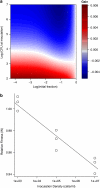High local substrate availability stabilizes a cooperative trait
- PMID: 21151005
- PMCID: PMC3105769
- DOI: 10.1038/ismej.2010.179
High local substrate availability stabilizes a cooperative trait
Abstract
Cooperative behavior is widely spread in microbial populations. An example is the expression of an extracellular protease by the lactic acid bacterium Lactococcus lactis, which degrades milk proteins into free utilizable peptides that are essential to allow growth to high cell densities in milk. Cheating, protease-negative strains can invade the population and drive the protease-positive strain to extinction. By using multiple experimental approaches, as well as modeling population dynamics, we demonstrate that the persistence of the proteolytic trait is determined by the fraction of the generated peptides that can be captured by the cell before diffusing away from it. The mechanism described is likely to be relevant for the evolutionary stability of many extracellular substrate-degrading enzymes.
Figures


Similar articles
-
Interaction between proteolytic strains of Lactococcus lactis influenced by different types of proteinase during growth in milk.Appl Environ Microbiol. 1997 Jun;63(6):2131-5. doi: 10.1128/aem.63.6.2131-2135.1997. Appl Environ Microbiol. 1997. PMID: 9172329 Free PMC article.
-
Growth and activities of Lactococcus lactis in milk enriched with low mineral retentate powders.J Dairy Sci. 1992 Sep;75(9):2344-52. doi: 10.3168/jds.S0022-0302(92)77994-6. J Dairy Sci. 1992. PMID: 1452841
-
Accumulation of casein-derived peptides during growth of proteinase-positive strains of Lactococcus lactis in milk: their contribution to subsequent bacterial growth is impaired by their internal transport.J Dairy Res. 2000 May;67(2):233-40. doi: 10.1017/s0022029900004192. J Dairy Res. 2000. PMID: 10840677
-
Latent bioactive peptides in milk proteins: proteolytic activation and significance in dairy processing.Crit Rev Food Sci Nutr. 2002;42(3):223-39. doi: 10.1080/10408690290825538. Crit Rev Food Sci Nutr. 2002. PMID: 12058981 Review.
-
Proteolytic enzymes of Lactococcus lactis.J Dairy Res. 1993 May;60(2):269-86. doi: 10.1017/s0022029900027606. J Dairy Res. 1993. PMID: 8320375 Review. No abstract available.
Cited by
-
Availability of public goods shapes the evolution of competing metabolic strategies.Proc Natl Acad Sci U S A. 2013 Aug 27;110(35):14302-7. doi: 10.1073/pnas.1308523110. Epub 2013 Aug 12. Proc Natl Acad Sci U S A. 2013. PMID: 23940318 Free PMC article.
-
Lytic bacteriophages affect the population dynamics of multi-strain microbial communities.Microbiome Res Rep. 2023 Sep 5;2(4):33. doi: 10.20517/mrr.2023.20. eCollection 2023. Microbiome Res Rep. 2023. PMID: 38045922 Free PMC article.
-
Genetic Elements Orchestrating Lactobacillus crispatus Glycogen Metabolism in the Vagina.Int J Mol Sci. 2022 May 17;23(10):5590. doi: 10.3390/ijms23105590. Int J Mol Sci. 2022. PMID: 35628398 Free PMC article.
-
Multifactorial diversity sustains microbial community stability.ISME J. 2013 Nov;7(11):2126-36. doi: 10.1038/ismej.2013.108. Epub 2013 Jul 4. ISME J. 2013. PMID: 23823494 Free PMC article.
-
Population dynamics of microbial cross-feeding are determined by co-localization probabilities and cooperation-independent cheater growth.ISME J. 2021 Oct;15(10):3050-3061. doi: 10.1038/s41396-021-00986-y. Epub 2021 May 5. ISME J. 2021. PMID: 33953364 Free PMC article.
References
-
- Bachmann H, de Wilt L, Kleerebezem M, van Hylckama Vlieg JE. Time-resolved genetic responses of Lactococcus lactis to a dairy environment. Environ Microbiol. 2010;12:1260–1270. - PubMed
-
- Chesson P. Mechanisms of maintenance of species diversity. Annu Rev Ecol Syst. 2000;31:343–366.
-
- den Hengst CD, van Hijum SA, Geurts JM, Nauta A, Kok J, Kuipers OP. The Lactococcus lactis CodY regulon: identification of a conserved cis-regulatory element. J Biol Chem. 2005;280:34332–34342. - PubMed
-
- Doebeli M, Hauert C. Models of cooperation based on the Prisoner's Dilemma and the Snowdrift game. Ecol Lett. 2005;8:748–766.

